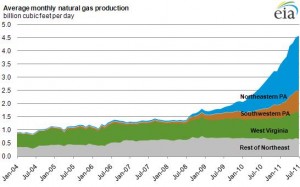Canonsburg, Pa. – One week ago, the U.S. Geological Survey (USGS) issued an updated Marcellus Shale resource assessment, indicating that the “region contains some 84 trillion cubic feet of undiscovered, recoverable natural gas, far more than thought nearly a decade ago,” as reported by the Associated Press. As noted by the AP, the updated USGS “figure is much higher than the last government assessment in 2002, which suggested about 2 trillion cubic feet of recoverable gas.”
And today, under the headline “Pennsylvania drives Northeast natural gas production growth,” the U.S. Energy Information Administration (EIA) reports that “According to Bentek Energy, LLC estimates, natural gas production in West Virginia and Pennsylvania now averages almost 4 billion cubic feet per day (Bcf/d), more than five times as much as the average from 2004 through 2008. It accounts for over 85% of total Northeastern natural gas production,” and offers this graph.
Over the course of the past week, while several flawed media reports surfaced regarding the new USGS data, straightforward facts ultimately prevailed. Below are several of these claims and corresponding facts. Most importantly, the latest production estimates remind us that, more than ever before, the dialogue about the Marcellus Shale continues to be rightfully focused on the region’s leading role in providing clean-burning, job-creating American energy for our nation.
CLAIMS: Citing Philip Budzik, an Energy Information Administration (EIA) bureaucrat who touts the work of anti-shale gas groups like the Natural Resources Defense Council (NRDC), Bloomberg News claims new USGS data will cause “U.S. to Slash Marcellus Shale Gas Estimate 80%.”
- The U.S. will slash its estimate of undiscovered Marcellus Shale natural gas by as much as 80 percent after a updated assessment by government geologists. The formation, which stretches from New York to Tennessee, contains about 84 trillion cubic feet of gas, the U.S. Geological Survey said today in its first update in nine years. That supersedes an Energy Department projection of 410 trillion cubic feet, said Philip Budzik, an operations research analyst with the Energy Information Administration. (Bloomberg News, 8/23/11)
- The New York Times’ Ian Urbina, in his story entitled “Geologists Sharply Cut Estimate of Shale Gas,” writes that the new USGS data “is drastically lower than the 410 trillion cubic feet that was published earlier this year by the federal Energy Information Administration,” and also cites Mr. Budzik. (New York Times, 8/24/11)
FACTS: USGS notes that “it’s important to do an apples-to-apples comparison here” – something Bloomberg News and the New York Times fundamentally failed to do. “Hold off on those shale gas obituaries,” accurately reports the Washington Post’s Brad Plumer.
- As it turns out, many of those stories may have been premature — and appear to be based on a slight misunderstanding of the USGS survey. … As Brenda Pierce, program coordinator for the USGS energy resources program told me, it’s important to do an apples-to-apples comparison here. The USGS and EIA aren’t measuring the same thing, exactly: The USGS offered an estimate of undiscovered resources that can be recovered with current technology, whereas the EIA report looked at both “active” and “undeveloped” reserves together. “Ours is additive to what’s already in production,” explains Pierce. … So the revision could end up being much less stark than early media reports implied. (Washington Post, 8/26/11)
- As [Kenneth Medlock, an energy fellow at Rice University’s Baker Institute] explains, the USGS figures refer only to “undiscovered” resources — which implies that gas that producers have already discovered cannot be included in the USGS assessment. The terminology favored by the EIA, meanwhile, implies that it can include resources that producers have already discovered. The variation can be significant. … The USGS estimate would theoretically exclude such reserves because they have already been discovered, while the EIA estimate could include them. … Medlock said that anybody who points to the latest USGS assessment as an indication that the Marcellus is less prolific than initially thought should take note of the magnitude of the increase. “They went from 2 Tcf to 84 Tcf. That’s a pretty big signal,” Medlock said. He also noted that shale has gone from accounting for just 1% of domestic gas production to 25% in less than ten years. “That doesn’t happen if it’s a Ponzi scheme,” Medlock said. (Energy Intelligence, 8/28/11)





